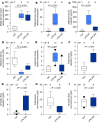Fetal and amniotic fluid iron homeostasis in healthy and complicated murine, macaque, and human pregnancy
- PMID: 31990688
- PMCID: PMC7101151
- DOI: 10.1172/jci.insight.135321
Fetal and amniotic fluid iron homeostasis in healthy and complicated murine, macaque, and human pregnancy
Abstract
Adequate iron supply during pregnancy is essential for fetal development. However, how fetal or amniotic fluid iron levels are regulated during healthy pregnancy, or pregnancies complicated by intraamniotic infection or inflammation (IAI), is unknown. We evaluated amniotic fluid and fetal iron homeostasis in normal and complicated murine, macaque, and human pregnancy. In mice, fetal iron endowment was affected by maternal iron status, but amniotic fluid iron concentrations changed little during maternal iron deficiency or excess. In murine and macaque models of inflamed pregnancy, the fetus responded to maternal systemic inflammation or IAI by rapidly upregulating hepcidin and lowering iron in fetal blood, without altering amniotic fluid iron. In humans, elevated cord blood hepcidin with accompanying hypoferremia was observed in pregnancies with antenatal exposure to IAI compared with those that were nonexposed. Hepcidin was also elevated in human amniotic fluid from pregnancies with IAI compared with those without IAI, but amniotic fluid iron levels did not differ between the groups. Our studies in mice, macaques, and humans demonstrate that amniotic fluid iron is largely unregulated but that the rapid induction of fetal hepcidin by inflammation and consequent fetal hypoferremia are conserved mechanisms that may be important in fetal host defense.
Keywords: Bacterial infections; Homeostasis; Innate immunity; Reproductive Biology.
Conflict of interest statement
Figures






Similar articles
-
Amniotic fluid, maternal and fetal blood insulin in overweight pregnant women.Horm Res. 1978;9(5):249-53. doi: 10.1159/000178920. Horm Res. 1978. PMID: 680636
-
Fibroblast growth factor 2 is elevated in term maternal and cord serum and amniotic fluid in pregnancies complicated by diabetes: relationship to fetal and placental size.J Clin Endocrinol Metab. 1995 Sep;80(9):2626-32. doi: 10.1210/jcem.80.9.7673405. J Clin Endocrinol Metab. 1995. PMID: 7673405
-
Maternal hepcidin determines embryo iron homeostasis in mice.Blood. 2020 Nov 5;136(19):2206-2216. doi: 10.1182/blood.2020005745. Blood. 2020. PMID: 32584957 Free PMC article.
-
Hepcidin and iron homeostasis during pregnancy.Nutrients. 2014 Aug 4;6(8):3062-83. doi: 10.3390/nu6083062. Nutrients. 2014. PMID: 25093277 Free PMC article. Review.
-
Metabolomics application in maternal-fetal medicine.Biomed Res Int. 2013;2013:720514. doi: 10.1155/2013/720514. Epub 2013 Jun 9. Biomed Res Int. 2013. PMID: 23841090 Free PMC article. Review.
Cited by
-
Role of Iron Metabolism-Related Genes in Prenatal Development: Insights from Mouse Transgenic Models.Genes (Basel). 2021 Sep 2;12(9):1382. doi: 10.3390/genes12091382. Genes (Basel). 2021. PMID: 34573364 Free PMC article. Review.
-
Lactoferrin for Prevention and Treatment of Anemia and Inflammation in Pregnant Women: A Comprehensive Review.Biomedicines. 2021 Jul 27;9(8):898. doi: 10.3390/biomedicines9080898. Biomedicines. 2021. PMID: 34440102 Free PMC article. Review.
-
Is the erythropoietin-erythroferrone-hepcidin axis intact in human neonates?Blood Cells Mol Dis. 2021 May;88:102536. doi: 10.1016/j.bcmd.2021.102536. Epub 2021 Jan 6. Blood Cells Mol Dis. 2021. PMID: 33450539 Free PMC article.
-
A mouse model characterizes the roles of ZIP8 in systemic iron recycling and lung inflammation and infection.Blood Adv. 2023 Apr 11;7(7):1336-1349. doi: 10.1182/bloodadvances.2022007867. Blood Adv. 2023. PMID: 36260707 Free PMC article.
-
Iron Homeostasis During Pregnancy: Maternal, Placental, and Fetal Regulatory Mechanisms.Annu Rev Nutr. 2023 Aug 21;43:279-300. doi: 10.1146/annurev-nutr-061021-030404. Epub 2023 May 30. Annu Rev Nutr. 2023. PMID: 37253681 Free PMC article. Review.
References
-
- Legge M. Second trimester amniotic fluid ferritin and transferrin levels in normal and anencephalic pregnancies. J Obstet Gynaecol (Lahore) 1983;4(1):14–15. doi: 10.3109/01443618309071216. - DOI

